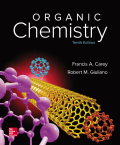
Concept explainers
Interpretation:
The
Concept introduction:
Reduction of monosaccharides with sodium borohydride reduces the
Oxidation of monosaccharides with bromine oxidizes the aldehyde group to carboxylic acid.
Oxidation of monosaccharides with nitric acid oxidizes the aldehyde group as well as the terminal
Carbohydrates undergo enolization in the open-chain form. The aldehyde oxygen is protonated by the hydrogen from C2, converting it to hydroxyl group and forming a double bond between C1 and C2.
Carbohydrates that differ in configuration only at C2 give the same enediol.
A molecule with more than one chirality center can be optically inactive if it has a plane of symmetry of a center of symmetry.
Want to see the full answer?
Check out a sample textbook solution
Chapter 24 Solutions
EBK ORGANIC CHEMISTRY
- A hexose was obtained after (+)-glyceraldehyde underwent three successive Kiliani–Fischer syntheses. Identify the hexose from the following experimental information: oxidation with nitric acid forms an optically active aldaric acid; a Wohl degradation followed by oxidation with nitric acid forms an optically inactive aldaric acid; and a second Wohl degradation forms erythrose.arrow_forwardd-Xylose and d-lyxose are formed when d-threose undergoes a Kiliani–Fischer synthesis. d-Xylose is oxidized to an optically inactive aldaric acid,whereas d-lyxose forms an optically active aldaric acid. What are the structures of d-xylose and d-lyxose?arrow_forwardWhat aldoses are formed when the following aldoses are subjected to the Kiliani–Fischer synthesis: (a) d-threose; (b) dribose; (c) D-galactose?arrow_forward
- Illustrate the treatment of methyl α-D-glucopyranoside with aqueous acid forms a mixture of α- and β-D-glucose and methanol ?arrow_forwardWhich aldoses are oxidized to optically inactive aldaric acids: (a) D-erythrose; (b) D-lyxose; (c) D-galactose?arrow_forwardDraw the expected product of the reaction of the following sugars with excess methyliodide and silver oxide.(a) a-d-fructofuranose (b) b-d-galactopyranosearrow_forward
- An aldose A, is reduced by sodium borohydride to an optically inactive alditol B. The Ruff degredation of A forms C. Oxidation of C by nitric acid generates the optically inactive diacid D. The ruff degreation of C forms D-glyceraldehyde. draw the structures for compounds A through D and discuss a mechanism for the reduction step using sodium borohydridearrow_forwardDeduce the structure of trehalose using 2,3,4,6-tetra-O-methyl-D-glucopyranosearrow_forwardDraw the product that is expected when the β-pyranose form of compound A is treated with excess ethyl iodide in the presence of silver oxide. The following information can be used to determine the identity of compound A: The molecular formula of compound A is C6H12O6. Compound A is reducing sugar. When compound A is subjected to a Wohl degradation two times sequentially, Derythrose is obtained. Compound A is epimeric with D-glucose at C3. The configuration at C2 is R.EXPLAIN IN DETAIL.arrow_forward
- Is bupropion chiral? If so, how many of the possible stereoisomers are formed in this synthesis?arrow_forwardShow the product that results when fructose is treated with an excess of methyl iodideand silver oxide.(b) Show what happens when the product of part (a) is hydrolyzed using dilute acid.(c) What do the results of parts (a) and (b) imply about the hemiacetal structure of fructose?arrow_forwardTreatment with sodium borohydride converts aldose A to an optically inactive alditol. Wohl degradation of A forms B, whose alditol is optically inactive. Wohl degradation of B forms d-glyceraldehyde. Identify A and B.arrow_forward
